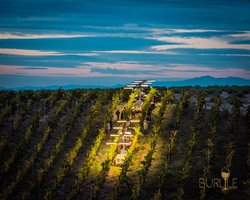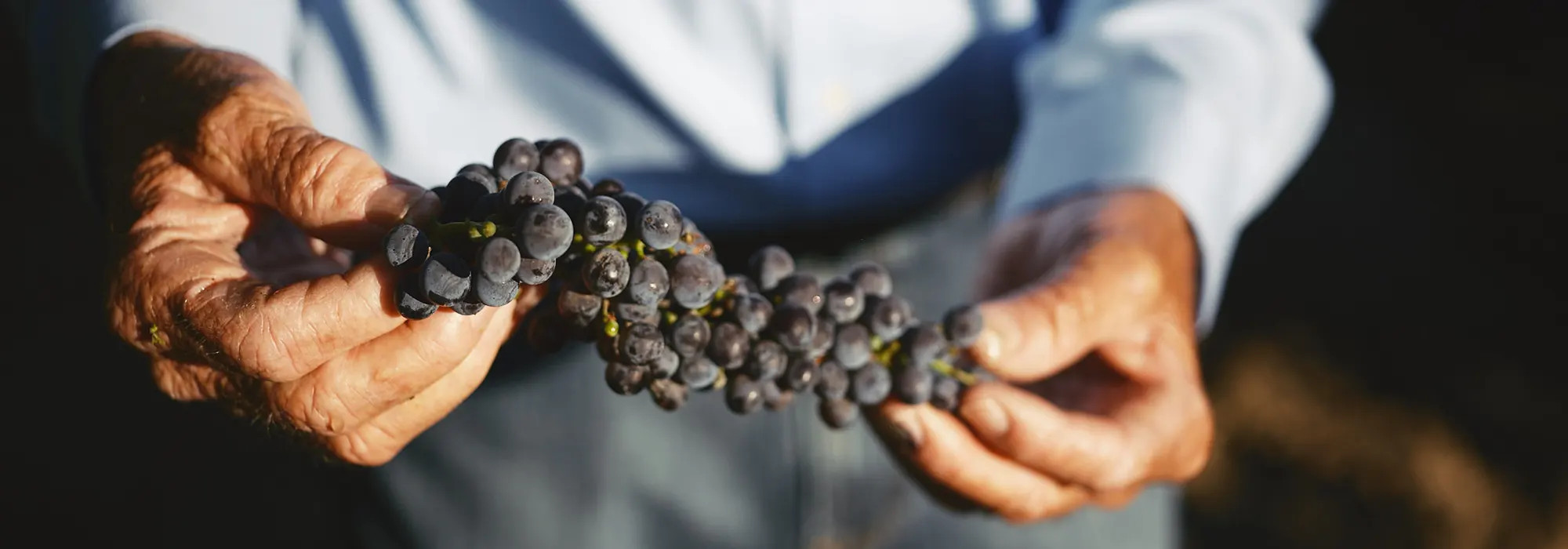It’s Official: Harvest is Here!
A Behind-the-Scenes Look at What Goes on in the Vineyard and Winery Before, During, and After Harvest in Temecula Valley

Equipment has been washed and sanitized. Bins have been readied. Summer vacations have been enjoyed, bodies rested and refueled for the work to come.
And then it begins. That perfect brix reading on the refractometer, telling winemakers and vineyard managers that the sugars in the grapes are where they want them to be. A quick sampling of a few berries straight off the vine indicate perfect phenolic ripeness – the grape skins have lost unpleasant, bitter flavors and have softened into something that will produce delicious, balanced wine. It’s go-time – the official kick-off of harvest. And it’s all underway in Temecula Valley Southern California Wine Country right now.
This is a busy time in the vineyard and the winery, and no day is the same. We caught up with a few Temecula Valley winemakers and winery staff to check in on how it’s all going, and what a typical day might look like at the winery during harvest. We also asked them if they have any superstitious, pre-harvest rituals and found out that winemaking isn’t all science and agriculture… it’s also a little bit of magic as well.
THE PREP
For the team at Peltzer Farm & Winery, the days leading up to harvest contain an energy shared by all. “Harvest season is usually an exciting state of limbo,” says Tasting Room Manager Danae Wager. “The grapes tell US when they’re ripe, so we wait on the sidelines in anticipation as the season begins. Typically, farmers wait until dark to pick the fruit, which preserves the sugar and acid levels needed to curate the desired end result that ends up in the bottle.”
Oak Mountain Winery owner Valerie Andrews paints a picture of the days and weeks leading up to the big moment when harvest officially begins:
“Oak Mountain’s harvest routine is to hurry and bottle everything in the tanks so we will have room for harvest. Next, we wash and test all equipment, as it has been sitting all year. Steve, by this time, has ordered yeasts and supplies so we are ready when Mother Nature says ‘go.’ We check last year’s timing of when we picked grapes and start testing sugar levels, then cross our fingers that we can get pickers to pick when we are ready. Fortunately, it always works out! Now it’s time for a glass of wine.”
Nick Palumbo, owner and winemaker at Palumbo Family Vineyards and Winery, compares prepping for harvest to getting ready for a busy night of service at a restaurant.
“[It’s like] Mise en Place,” he explains. “This is a French term often used in professional cooking that roughly translates into ‘Get your act together!’ But what it really means is, before you get started, gather all you will need, do your prep work and make sure everything is in place. The best run restaurants as well as wineries know this well and plan ahead. Harvest is and can be unpredictable, chaotic and fast-paced but if you are ready it can also be smooth and predictable.”
Some pre-harvest rituals are more superstitious. “We bury 11 pennies in the ground on the first day of harvest,” says Sharon Cannon, Director of Operations for Akash Winery. “It’s an Indian good luck tradition that [Co-owner] Mrs. Patel started for the winery.”
Or they’re just plain sensible:
Says Joe Wiens, winemaker at Wiens Family Cellars: “We don’t really have any pre-harvest rituals besides stocking up the fridge with beer!”
THE REAL WORK
So once all of the pieces are in place, what does an actual day of working harvest look like?
Joe Wiens shares a snapshot of what the day-to-day can look like during this exciting time in Wine Country:
“We typically get in at 6 or 7 AM. One of us will start with turning caps on our fermenting reds, while the other weighs the newly delivered fruit. We taste the fermenting reds (not the most fun thing in the world at 6am!) and decide if anything is ready for pressing. The remainder of our workday entails racking settling wines, pressing and processing, and running lab analysis.”
While it’s exhausting work, Joe credits the sense of community and shared responsibility for getting them through it. “Our team has been together for years, and everyone is trained on many of our responsibilities from processing, to preparing yeast additions, to lab analysis and data entry,” he says. “We get the music going early and all work really well together to make the long days feel shorter.”
“Our days here at Palumbo start as early as 2 am and can last well into the night,” shares Nick Palumbo. “Then off to sleep for a few hours before starting again. We are a small, family winery so everyone gets involved. We are in the field sorting leaves out of the bins, then off to the crush pad for processing, fermenting, pressing, and barreling. There is a lot to do but somehow, we get it done each year. As we have always said we don’t have a choice; it will get done somehow.”
“A typical day consists of early morning vineyard visits to collect grape samples for analysis, brix and temperature readings on all fermenting wines, smelling the top of each fermenting tank to make sure there are no ‘off’ odors or nutrient deficiencies, and most importantly, tasting each lot daily,” explains Olivia Bue, Winemaker at Robert Renzoni Vineyards.
“And, once the reds come in, the real harvest bootcamp begins, with pumpovers three times a day, with at least three hours off in between. This involves sanitizing all hoses and pumps before and after each lot. As the reds approach the end of alcoholic fermentation its time press the wine off the skins… Each day consists of a lot of cleaning and scrubbing.”
Olivia says the hardest part of her day is when the alarm goes off at 3 AM. It’s also incredibly rewarding with moments of beauty as well. “[I love] processing the grapes as the sun rises,” she says. “I also love when the last lot is pressed out – not because harvest is over, but because I can look back and feel proud of all the blood, sweat, and tears put into the vintage.”
She also loves the team building that happens over their traditional 9AM happy hours.
Over at Wilson Creek, the day-to-day looks similar. And they get ready for the mammoth task ahead by going out for pizza and beer the Friday before harvest begins.
“We start picking at 10 PM and, depending upon the varietal, we finish with the harvest crew at 3 am,” says Wilson Creek Winery winemaker Gus Vizgirda. “The cellar crew kicks in on the crushpad at 4 AM. Whites are crushed and pressed and put in the tanks. Reds are crushed and put in the tank for two weeks for fermentation.”
With a total of 140 acres to harvest, this goes on for about 2.5 months, with two crews of twenty people working seven days a week. This hard work is recognized and rewarded in two ways. First, Gus arrives every morning at sunrise when the grapes are on the crushpad, and he plays the bugle for everyone – including the grapes.
Head on over to Lorenzi Estate Wines and you will see their crew at 3 AM, planning the day, taking readings, doing pumpovers, and picking crop starting around 4 AM, with the goal of being done by lunchtime so that they can avoid that Southern California midday heat in early Fall.
At Gershon Bachus, the dawn patrol continues, with the picking crew arriving around 3AM as well to pick the fruit and drop it at the winery’s production area.
“Our team arrives by 7AM,” explains Gershon Bachus owner Christina Falik and winemaker Dakota Denton. “For our hillside vineyards, we have a team picking out the leaves and bad clusters as the grapes take a ride on the elevator. The winemaking staff secures the connections to our concrete tanks where the fruit will go through fermentation. Then the pumpovers begin in order to make sure the must stays wet. This is done twice per day, until fermentation is done. Harvest for us goes fast, and is intense, as the fruit tends to ripen at a similar pace.”
What many people don’t realize is just how physically demanding harvest and winemaking are, requiring long hours, heavy-lifting, and early starts. “On a complicated day you can crush/destem, pump over, press, and move wine into barrels,” continues Christina. “This is not a day for the weary.”
The excitement – and work! – of harvest isn’t limited to those working in the vineyards or cellar. Oftentimes, the experience is shared by everyone at the winery.
“We love to gather and watch or participate in picking the fruit and making memories together,” says Danae at Peltzer. “Seeing the process firsthand and learning exactly how each grape is processed reignites our passion for farming and high-quality winemaking. We typically order pizza and invite the families of our staff to join in the festivities and ask as many questions as possible!”
THE AFTERMATH
And when it’s all over? At Wilson Creek, once harvest is complete, the team has a huge – and well-deserved – harvest party among the vines.
And they’re not the only ones celebrating a job well done. “Our end-of-harvest ritual is a PARTY,” says Christina. “Since our season is so short, it precedes the holiday season and is just as festive.”
Photo courtesy of Matthew Burlile- Instagram: @temeculaphotography







